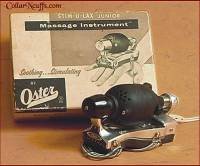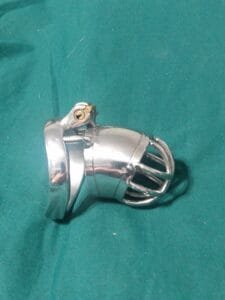What is the history of vibrators?
Table of Contents
A condition called Female Hysteria and lazy doctors: is the short reply:
Until it was finally laid to rest the mid-20th century, female hysteria was a favored diagnosis for physicians for a litany of symptoms. As you’d guess from its vernacular, female hysteria was a condition which afflicted women exclusively. Symptoms of this dread disease included anxiety, crying fits, surliness, faintness, nervousness, insomnia, fluid retention, heaviness in the abdomen, muscle spasms, shortness of breath, irritability and a loss of appetite for food. and any behavior that a Victorian-era husband would find improper from his wife. In 1859, it was claimed that a quarter of all women suffered from hysteria. This number makes sense if you consider that there was a 75-page catalog with possible symptoms, and that this list was seen as incomplete.

Dating from Plato’s dialogs, female hysteria was assumed to be caused by the womb roving around within a woman’s body, mucking up the works. Galen, famed physician of the 2nd century, was the first to trip onto the notion that this might have something to do with female sexual satisfaction. He noted that deprivation of orgasm among healthy women brought on classic female hysteria symptoms, noting that pelvic massage often brought about beneficial results in the patient.

Not a big surprise; a good orgasm can do wonders for your day: MissBitch
Early treatments for female hysteria revolved around female hysteria massage; allowing the patient to achieve female sexual satisfaction was the goal of pelvic massage, but such blunt talk about orgasm wasn’t bandied about in a proper gentlemanly doctor’s office. By performing an effective female hysteria massage manually, the physician would bring his patient to orgasm, and the dreaded malady would be kept at bay—until it was time for the next treatment. Female hysteria was a gold mine. It wasn’t fatal, and early treatments for female hysteria such as pelvic massage had to be repeated frequently for the good of the patient. Still, achieving female sexual satisfaction through a pelvic massage performed by hand might be all fine and good for the patient, but it was a time-consuming process for doctors. A proper female hysteria massage required quite a bit of stamina as well. There had to be a better procedure to add to the early treatments for female hysteria—one that was effective in bringing the patient to orgasm and one that could do the job quickly and easily.
The solution? Vibrators
The earliest vibrators were a far cry from the sleek, streamlined sex toys commonplace in the bedroom today. These truly monstrous devices, they weren’t anything that women would be likely to turn to for female sexual satisfaction today. There were hydrotherapeutic models that dispensed huge jets of water aimed straight toward the clitoris at an alarming rate, but they were guaranteed by their manufacturers to offer all of the therapeutic benefits of a manual pelvic massage in a fraction of the time.
MissBonnieAs long as the patient didn’t mind looking like a drowned rat following the treatment, all was good.
plain and simple the modern vibrators were created as labor-saving devices for the treatment of female hysteria. To the Victorian-era male, women were frail, flighty creatures, subject to strange mental and emotional afflictions. The treatment was pelvic massage to induce orgasm, and many physicians found it strenuous and unnecessarily time-consuming. Surely there was a less strenuous way
You’ve got to use your hand to bring a woman to orgasm? Horrors. Oh you poor, poor boy!
MissBitch

Enterprising engineers came to the rescue with vibrators.

George Taylor’s steam powered vibrators were perhaps the first patented mechanical vibrating devices. The first electromechanical vibrator was designed in 1880 by a British physician, Joseph Mortimer Granville. Although his model more closely resembled what we think of as a vibrator, Granville did not support the use of vibrating devices for inducing female orgasm. He intended it to be used to massage male skeletal muscles.
However, the technology proved to be completely adaptable.
Then, in 1902, the American company Hamilton Beach patented the first electric vibrator available for retail sale, making the vibrator the fifth domestic appliance to be electrified, after the sewing machine, fan, tea kettle, and toaster, and about a decade before the vacuum cleaner and electric iron.
Advertisements for electric vibrators and battery vibrators were common within the pages of contemporary women’s magazines such as Needlecraft, Woman’s Home Companion, Modern Priscilla. Vibrators were marketed as therapeutic aids, and no mention of the sexually stimulating properties of the new electric vibrators and battery vibrators were mentioned in the advertising copy. Still, while many men still clung to beliefs that women were above sexual desires and feelings, women of the era eagerly used the many types of vibrators available to experience what they weren’t getting from their marriages.


Vibrators’ time in the sun came to a crashing halt with the widespread distribution of stag films in the 1920s. The frequent appearances of many types of vibrators in the explicit action stigmatized vibrators, which were now associated with loose morals. Electric vibrators and battery vibrators disappeared from mainstream America for around four decades.
Then came the sexual revolution of the 1960s. Vibrators made their way into adult bookstores, electric vibrators and battery vibrators were sold through mail-order outlets, and as time passed and sex toys became relatively mainstream, various and sundry types of vibrators became readily available and the sheer breadth and variety of their functions expanded dramatically. Sex toy consumers can choose from the traditional phallic vibrators, dual-action vibrators which concurrently stimulate the vagina and clitoris, g-spot vibrators to reach and stimulate the g-spot reliably, p-spot vibrators to perform the same function for the prostate, and discrete vibrators that look anything like a sex toy. Today’s vibrators can be set to any speed and intensity the user might desire, and almost all types of vibrators have remote control capability. Because we consumer giants just love anything and everything remote controlled, especially if the remote has a zillion buttons. Vibrators have regained their day in the sun, and we seem to be a lot happier for it
Where can I see or buy antique vibrators?
The Antique Vibrator and Quack Medical Museum is a private collection that can be viewed online. Antique vibrators are often on sale on eBay, and may be available through antique dealers who trade in small appliances.
Resource Article : MissBonnie and MissBitch for The Beginner’s Guide to Vibrators © CollarNcuffs.com
Reference Sources:
The Technology of Orgasm: “Hysteria,” the Vibrator, and Women’s Sexual Satisfaction by Rachel P. Maines
“Sex Toy History” by Michael Castleman
“The Technology of Orgasm and the Vibrator” by Natalie Angier. Maines, Rachel P. (1998).
The Technology of Orgasm: “Hysteria”, the Vibrator, and Women’s Sexual Satisfaction. Baltimore: The Johns Hopkins University Press. ISBN 0-8018-6646-4.\\ Micale, Mark S. (1993). “On the “Disappearance” of Hysteria: A Study in the Clinical Deconstruction of a Diagnosis” Micale, Mark S. (July 2000).
“The Decline of Hysteria”. Harvard Mental Health Letter 17 (1): 4–6.
Article: MissBonnie and MissBitch for The Beginner’s Guide to Vibrators © CollarNcuffs.com
Many, many thank yous to Cle-Andria for her help with images, allowing us to destroy her shop shelves in the name of kink, and her wealth of information.







